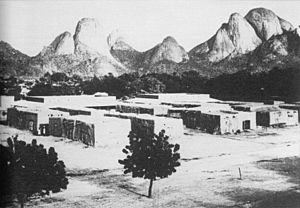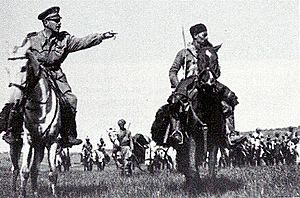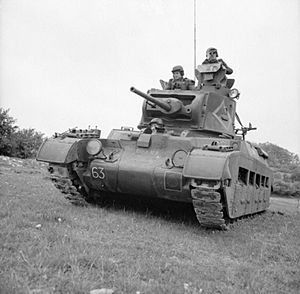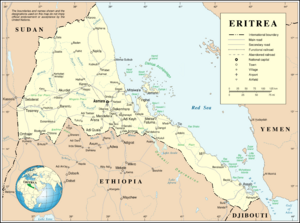Battle of Agordat (1941) facts for kids
Quick facts for kids Battle of Agordat |
|||||||
|---|---|---|---|---|---|---|---|
| Part of The East African Campaign (World War II) | |||||||
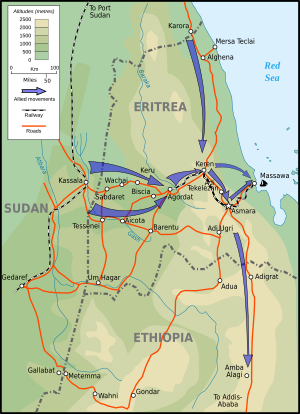 British invasion of Eritrea, 1941 |
|||||||
|
|||||||
| Belligerents | |||||||
| Commanders and leaders | |||||||
| Archibald Wavell William Platt Noel Beresford-Peirse |
Duke of Aosta Orlando Lorenzini |
||||||
| Units involved | |||||||
| Gazelle Force 4th Indian Division 5th Indian Division (less one brigade) |
2nd Colonial Division | ||||||
| Strength | |||||||
| 2 infantry divisions Sudan Defence Force (elements) |
6,000–7,000 men | ||||||
| Casualties and losses | |||||||
| 1,500–2,000 prisoners 14 tanks 43 guns |
|||||||
The Battle of Agordat was a fight that happened near Agordat in Eritrea. It took place from January 26 to 31, 1941. This battle was part of the East African Campaign during the Second World War.
The battle involved the Italian army and their local colonial troops. They fought against forces from Britain, the Commonwealth, and India. The British had a big advantage because they could read Italian secret messages. This gave them lots of information about the Italian army and air force plans.
Italian and colonial troops had been ordered to leave Kassala in Sudan. So, the British started their attack into Eritrea earlier than planned, in mid-January. Agordat was a very strong defensive spot. The British advance was slowed by small fights and roads full of mines.
The main attack started on January 28 on the left side, but it was pushed back. Fierce fighting continued on the hills and plains until January 31. Then, the British attacked with four Matilda tanks and Bren Gun Carriers. These tanks easily destroyed the Italian Fiat M11/39 tanks. This forced the Italian soldiers to retreat.
To avoid being trapped, the Italians quickly pulled back to Keren. They left behind about 1,000 prisoners, many guns, and 14 destroyed tanks. Another 1,000 men were captured as the British chased them. The Battle of Agordat was a big victory for the British. It was followed by the Battle of Keren (February 5 – April 1). This battle led to the fall of the Eritrea Governorate.
Contents
How the Battle Started
Italy Takes Kassala
Amedeo, Duke of Aosta was Italy's leader in Italian East Africa. He ordered an attack on Kassala in Anglo-Egyptian Sudan on July 4, 1940. This was after Italy declared war on Britain and France. About 6,500 Italian and local soldiers attacked. They had help from the Italian Royal Air Force (called Regia Aeronautica).
Kassala was defended by fewer than 500 soldiers from the Sudan Defence Force (SDF). The SDF soldiers stayed hidden during a 12-hour bombing by Italian planes. Then, they destroyed six Italian tanks. They also caused many casualties for the attackers. Italian cavalry entered Kassala, and the defenders pulled back.
During the attack on Kassala, General Pietro Gazzera captured the Sudan fort of Gallabat. He used Italian colonial troops and local irregular fighters. Gallabat was then made stronger. Another town, Kurmuk, was also taken by the Italians.
These Italian attacks gave them a good entry point into Sudan. They also made it harder for the British to help Ethiopian resistance fighters. The SDF kept fighting near Kassala. The British made the Italians think there were many more British and Sudanese troops in the area. An Italian map even showed they believed about 20,000 British and Sudanese troops were there.
Italy's Plans for Defense
After taking British Somaliland, the Italians in East Africa decided to defend their positions. By late 1940, Italy had lost battles in the Mediterranean and North Africa. General Ugo Cavallero, a new Italian military leader, changed their strategy. He ordered Italian forces in East Africa to move to stronger defensive spots.
The Italian commander, Frusci, was told to leave Kassala and Metemma. These were lowland areas near the Sudan–Eritrea border. He was to hold the mountain passes instead, which were easier to defend. Frusci didn't want to leave the lowlands. It would look bad after he had said the British would be defeated. Kassala was also an important railway hub. Holding it stopped the British from using the railway to bring supplies from Port Sudan.
Britain's Plans for Attack
In November 1940, a British unit called Gazelle Force attacked Italian outposts near Kassala. In December, the British decided to help Ethiopian resistance fighters. They also planned to keep pressure on the Italians at Gallabat. Kassala was to be taken back in early January 1941. This would stop the Italians from moving further into Sudan.
The 4th Indian Infantry Division was moved from Egypt to Sudan. With success in Egypt, winning in East Africa became the next big goal. The British wanted to defeat the Italian forces by April 1941.
The British offensive was planned for February 8. It would be a two-sided attack on Kassala. But the Italians started pulling back from Kassala and other areas on January 18. This made the British attack start earlier, on January 19. British leaders were told to chase the Italians hard.
Secret Messages (Ultra)
The British had a secret advantage called Ultra. By late 1940, British code-breakers had cracked Italian military codes. This meant they could read Italian messages. They learned about the Italian army's setup and supplies. Sometimes, British commanders got messages even before the Italian commanders did! This secret information greatly helped the British plan their attacks.
Getting Ready for Battle
Italian Retreat
By late 1940, the Italian command decided to leave Kassala and Gallabat. These towns in Sudan were hard to hold. The Italian 12th Colonial Brigade left Kassala on the night of January 17/18, 1941. This showed the British that Italy's situation was getting worse. The British attack from Sudan was moved up to January 19.
The Italian troops pulled back towards the mountains of Eritrea. They fought some small battles to slow down the British. As the British Gazelle Force tried to go around them, the Amhara Cavalry (local soldiers on horseback) tried to stop them. On January 21, the cavalry made a surprise charge. They caused confusion among the British and Indian forces.
The cavalry lost about 800 men killed or wounded. But their brave charge slowed the British for long enough. This allowed the main Italian force to reach Agordat.
Agordat's Defenses
Agordat was a naturally strong place for defense. Its defenses mostly blocked attacks from the southwest. The Baraka riverbed protected the northern side. Two roads from Kassala led to Agordat. These roads joined at Agordat and then went to Keren, which was the only way to Asmara.
Agordat was a small town by the Baraka river. To the southwest, there was a ridge called Laquetat. It had forts, wire fences, and a concrete wall. To the southeast, the Italians built forts on four rocky hills. Beyond them was Mount Cochen, which was about 2,000 feet high.
The British 4th Indian Division moved towards Agordat. They were joined by Matilda tanks. The 5th Indian Division was to capture Aicota. Italian rearguards (small groups fighting to slow down the enemy) tried to stop the British. But by January 25, the Allies had cut the Italian supply lines between Agordat and Barentu.
On January 26, British and Indian artillery bombed the Italian defenses. South African Air Force planes destroyed most of the Italian aircraft. This gave the British control of the sky. By January 27, most of the two Indian divisions were near Agordat.
The Battle of Agordat
Fighting from January 28–30
On January 28, the 4th Indian Division tried to go around the Italian defenses north of Agordat. Four Matilda tanks arrived. Indian soldiers moved towards Laquetat without much resistance. Other Indian troops reached the top of Mount Cochen after dark.
The 4th Sikh and 3/2nd Punjab battalions attacked Laquetat ridge during the night of January 28/29. But they were pushed back. Fighting continued all through January 29. More Italian battalions arrived and counter-attacked, pushing back the Indian soldiers.
Supplies like ammunition and water had to be carried by hand. The soldiers even had to fight while carrying supplies. The Italians also got some small mountain guns behind Mount Cochen. This forced the attackers to pull back. Three Indian battalions attacked again and pushed the Italians back. On the plain, the 2nd Cameron battalion captured a spot called Gibraltar. They fought off several Italian counter-attacks.
The Final Attack on January 31
The attack on Mount Laquatat and the pass nearby began again. The 1st Battalion, Royal Fusiliers led the way, supported by the four Matilda tanks. This was the last obstacle before the Agordat plain. The final attack happened between 11:00 a.m. and 2:00 p.m.
The Matilda tanks easily crushed the Italian defenses. They destroyed Italian artillery and eleven Italian M11/39 and L3 tanks. Some of these tanks were even driven by German volunteers. Several counter-attacks by Italian and local cavalry failed.
The Italian defenders worried about being trapped if the road to Keren was cut. So, they began a confused retreat towards Keren. The Indian and British soldiers chased them towards Agordat. The British captured 1,000 prisoners, 14 damaged tanks, 43 guns, and all the heavy equipment. During the chase, another 1,000 prisoners were taken. Agordat was taken by the British on February 1.
The Fight for Barentu
Barentu was a fortified town with an airfield. It was surrounded by steep hills. The town was defended by about 8,000 Italian and local soldiers. They had 36 tanks and 32 mountain guns.
On January 21, the 29th Indian Infantry Brigade advanced towards Barentu. They faced Italian colonial troops. The Indians managed to go around the Italian defenses. On January 25, they met another Italian rearguard. An attack before dawn was pushed back.
The 10th Indian Infantry Brigade advanced from Agordat. They found that the Italians had blown up rocks and boulders to block the road. The Italian defenders fought hard to slow them down. On January 31, British soldiers captured some high ground. They faced extreme heat and thirst, moving through thorny bushes.
The Italians were forced out of two defense lines. But they had planned for this and fired mortars and machine guns on their old positions. A Sudanese machine-gun company found a way to go around the Italian defenders. As news spread that Agordat had fallen, the Barentu defenders pulled back. They left behind many prisoners, guns, and tanks. The first British and Indian troops found hot food in the Italian kitchens.
After the Battle
Losses
During the battle and retreat from Agordat, between 1,500 and 2,000 Italian and local soldiers were captured. From Agordat, Barentu, and the retreat to Keren, the Italian and colonial forces lost many men. This included 179 officers, 130 non-commissioned officers, and over 15,000 other soldiers.
The Italians also lost 96 guns, 231 machine guns, 329 automatic rifles, and many vehicles and tanks.
See also
- List of British military equipment of World War II
- List of Italian Army equipment in World War II



